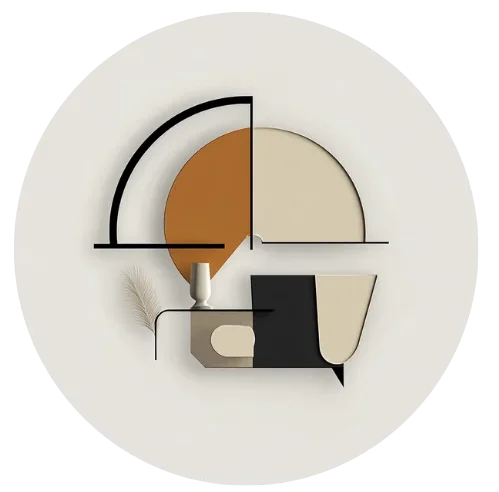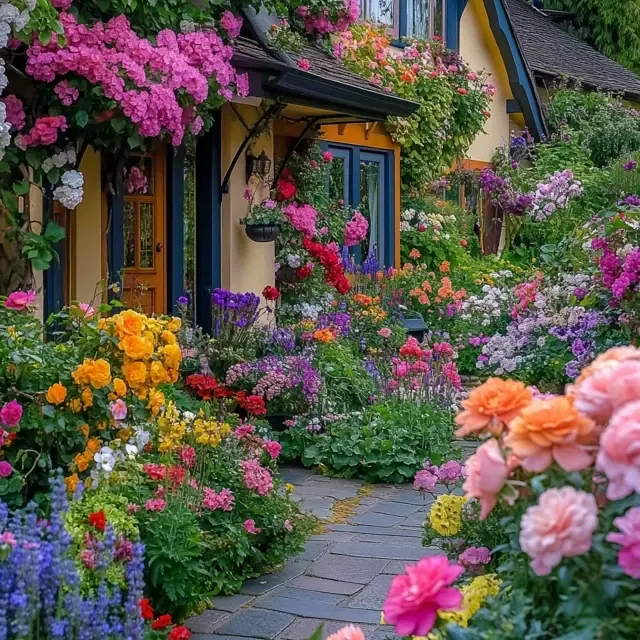Introduction to Flower Garden Design
Designing a beautiful flower garden is both an art and a science. It’s about creating a space that is visually pleasing, fragrant, and teeming with life. Whether you have a sprawling backyard or a small urban plot, a well-designed flower garden can transform your outdoor space into a vibrant and inviting oasis. This guide will walk you through the essentials of flower garden design, from selecting the right flowers to incorporating decorative elements that enhance the beauty of your garden.
Why Create a Flower Garden?
Creating a flower garden is a wonderful way to express your creativity, connect with nature, and add beauty to your home. A flower garden can serve as a peaceful retreat, a source of fresh flowers for your home, and a habitat for pollinators like bees and butterflies. It’s also an opportunity to experiment with color, texture, and form, and to create a space that reflects your personal style. Whether you’re an experienced gardener or a novice, designing a flower garden is a rewarding endeavor that brings joy and satisfaction.
The Benefits of a Well-Designed Flower Garden
A well-designed flower garden offers numerous benefits. It enhances the curb appeal of your home, making it more inviting and attractive. A garden filled with a variety of flowers can also provide year-round interest, with different plants blooming at various times. Additionally, a flower garden can improve your mental and physical well-being by providing a space for relaxation, exercise, and fresh air. The process of planning and caring for a garden can also be a therapeutic and stress-relieving activity.
Common Mistakes in Flower Garden Design
Even with the best intentions, it’s easy to make mistakes when designing a flower garden. Some common pitfalls include choosing the wrong plants for your climate or soil type, overcrowding plants, and neglecting to plan for year-round interest. Another mistake is failing to consider the mature size of plants, which can lead to a garden that feels cramped or overgrown. Avoiding these mistakes is key to creating a garden that is both beautiful and easy to maintain.
Planning Your Flower Garden
Before you start planting, it’s important to plan your flower garden carefully. Start by assessing your space and considering factors like sunlight, soil quality, and water availability. Think about the style and color scheme you want to achieve, and make a list of the flowers you want to include. Consider how you can create a layout that is both functional and aesthetically pleasing, with a mix of heights, colors, and textures. A well-thought-out plan will serve as a blueprint for your garden, helping you create a space that is cohesive and harmonious.
Choosing the Right Location
The location of your flower garden is one of the most important factors in its success. Flowers need the right combination of sunlight, soil, and water to thrive.
Understanding Sunlight and Shade Requirements
Different flowers have different sunlight requirements, so it’s important to choose a location that meets the needs of the plants you want to grow. Most flowers require full sun, meaning they need at least 6 to 8 hours of direct sunlight each day. However, some flowers, such as hostas and ferns, prefer partial shade or even full shade. When selecting a location for your garden, observe how the sunlight moves across your space throughout the day and choose plants that are well-suited to the amount of light available.
Soil Quality and Preparation
Healthy soil is the foundation of a successful flower garden. Most flowers prefer well-draining soil that is rich in organic matter. Before planting, test your soil to determine its pH level and nutrient content. If your soil is too acidic or lacks nutrients, amend it with compost, aged manure, or other organic matter to improve its structure and fertility. Consider using raised beds if your soil is heavy clay or sandy, as they can provide better drainage and root development.
Drainage and Watering Considerations
Proper drainage is essential for preventing root rot and other water-related problems in your flower garden. Ensure that your garden site has good drainage, especially if you’re planting in a low-lying area. If necessary, improve drainage by adding organic matter or creating raised beds. Also, consider the availability of water when choosing a location for your garden. If your garden is far from a water source, you may need to install a drip irrigation system or use soaker hoses to ensure your flowers receive adequate moisture.
Space and Layout Planning
When planning your flower garden, consider the space available and how you can make the most of it. Even a small garden can be visually stunning with the right layout. Think about how you’ll arrange your plants to create a balanced and harmonious design. Consider the mature size of your plants and leave enough space for them to grow without overcrowding. Also, think about how you’ll access your garden for maintenance and enjoy the view from different angles. A well-planned layout will make your garden easier to care for and more enjoyable to spend time in.
Selecting Flowers for Your Garden
Choosing the right flowers is key to creating a garden that is both beautiful and diverse. Consider factors like color, bloom time, fragrance, and pollinator attraction when selecting flowers for your garden.
Perennials vs. Annuals: Pros and Cons
When selecting flowers for your garden, it’s important to understand the difference between perennials and annuals. Perennials are plants that come back year after year, providing long-lasting color and structure to your garden. Some popular perennials include peonies, daylilies, and hostas. Annuals, on the other hand, complete their life cycle in one growing season and need to be replanted each year. While annuals require more maintenance, they often offer more vibrant colors and longer bloom times than perennials. Consider using a mix of both types to create a garden that provides continuous interest throughout the growing season.
Choosing Flowers by Color and Bloom Time
Color is one of the most important elements in flower garden design. When choosing flowers for your garden, consider how different colors will work together to create a cohesive and visually pleasing palette. You can choose complementary colors for a vibrant and energetic look, or stick to a monochromatic scheme for a more calming and sophisticated feel. Additionally, consider the bloom time of your flowers to ensure that your garden has color throughout the growing season. By selecting flowers that bloom at different times, you can create a garden that is always in bloom.
Incorporating Fragrant Flowers
Fragrance is an often-overlooked aspect of garden design, but it can add a whole new dimension to your flower garden. Fragrant flowers like lavender, roses, and jasmine can create a sensory experience that enhances the beauty of your garden. When selecting fragrant flowers, consider where you’ll plant them to make the most of their scent. For example, plant fragrant flowers near seating areas, pathways, or windows where you’ll be able to enjoy their aroma. Be mindful of combining too many strong scents in one area, as this can become overwhelming.
Native and Pollinator-Friendly Flowers
Incorporating native and pollinator-friendly flowers into your garden is a great way to support local wildlife and create a more sustainable garden. Native plants are adapted to your region’s climate and soil conditions, making them easier to care for and more resilient. Pollinator-friendly flowers, such as coneflowers, bee balm, and milkweed, provide essential food sources for bees, butterflies, and other pollinators. By choosing flowers that benefit local ecosystems, you can create a garden that is not only beautiful but also environmentally friendly.
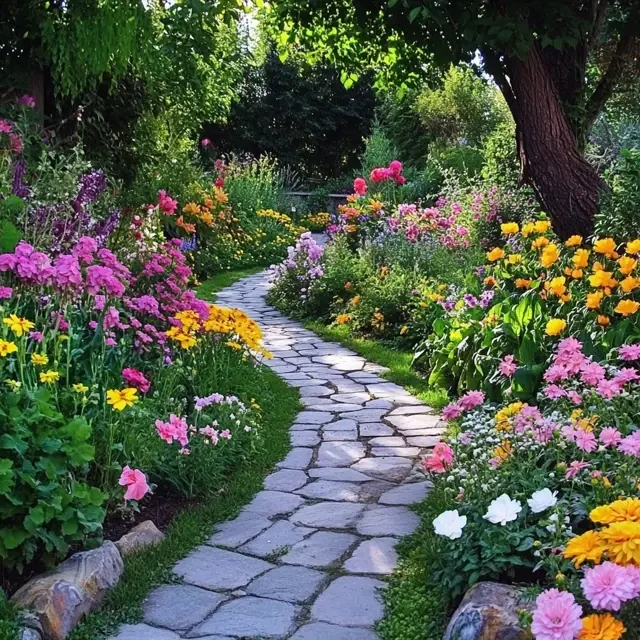
Designing Your Garden Layout
The layout of your flower garden plays a crucial role in its overall appearance and functionality. A well-designed layout creates visual interest and ensures that your garden is easy to navigate and maintain.
Creating a Focal Point
A focal point is a key element in garden design that draws the eye and creates a sense of balance and harmony. In a flower garden, a focal point can be a large plant, a sculpture, a water feature, or even a brightly colored flower bed. When designing your garden, think about where you want to direct attention and how you can use a focal point to anchor your design. Position your focal point in a prominent location, such as at the end of a pathway or in the center of a flower bed, to create a strong visual impact.
Layering Plants for Visual Interest
Layering plants is a technique used to create depth and visual interest in a garden. By arranging plants of different heights, textures, and colors in layers, you can create a dynamic and visually appealing design. In a flower garden, start by placing taller plants at the back of the bed, followed by medium-height plants, and then shorter plants at the front. This layering effect allows all plants to be visible and prevents taller plants from overshadowing smaller ones. Additionally, consider the texture and color of the foliage to add even more depth to your design.
Using Garden Structures and Features
Garden structures and features, such as trellises, arbors, and pergolas, can add height and structure to your flower garden. These elements provide support for climbing plants like roses and clematis, and they can also create a sense of enclosure and intimacy in your garden. Consider incorporating a trellis or arbor as an entrance to your garden or as a backdrop for a flower bed. Garden features like benches, birdbaths, and statues can also enhance the aesthetic appeal of your garden while providing functional elements for relaxation and wildlife.
Planning for Year-Round Interest
A well-designed flower garden should provide visual interest throughout the year, not just during the peak blooming season. To achieve this, plan your garden with a mix of plants that offer different textures, colors, and forms in each season. Include evergreen plants for winter interest, spring bulbs for early color, and summer perennials for long-lasting blooms. In the fall, choose plants with colorful foliage or interesting seed heads. By planning for year-round interest, you can create a garden that is beautiful and engaging no matter the season.
Planting and Caring for Your Flower Garden
Proper planting and care are essential for the health and longevity of your flower garden. By following best practices, you can ensure that your flowers thrive and your garden remains vibrant.
Proper Planting Techniques
Proper planting techniques are crucial for the success of your flower garden. Start by digging a hole that is twice as wide and just as deep as the root ball of your plant. Gently remove the plant from its container, being careful not to damage the roots. Place the plant in the hole, ensuring that the top of the root ball is level with the soil surface. Backfill the hole with soil, pressing down gently to remove any air pockets. Water the plant thoroughly to help it establish roots.
Watering and Mulching Strategies
Watering is one of the most important aspects of flower garden care. Most flowers prefer consistent moisture, so it’s important to water deeply and regularly, especially during dry periods. To conserve moisture and reduce the need for frequent watering, apply a layer of organic mulch, such as wood chips or straw, around your plants. Mulch also helps suppress weeds and regulate soil temperature, creating a more favorable environment for your flowers. Be sure to water early in the morning or late in the evening to reduce evaporation and avoid wetting the foliage, which can lead to disease.
Fertilizing for Healthy Growth
Fertilizing your flower garden ensures that your plants have the nutrients they need to grow strong and produce abundant blooms. Use a balanced, slow-release fertilizer or organic compost to provide essential nutrients throughout the growing season. Follow the recommended application rates on the fertilizer package to avoid over-fertilizing, which can lead to excessive foliage growth at the expense of flowers. Additionally, consider using a liquid fertilizer during the growing season to give your plants an extra boost of nutrients.
Pruning, Deadheading, and Maintenance Tips
Regular pruning and deadheading are essential for maintaining the health and appearance of your flower garden. Prune your plants to remove dead or damaged growth, encourage bushier growth, and improve air circulation. Deadheading, or removing spent flowers, helps prevent plants from setting seed and encourages continuous blooming. Additionally, keep an eye out for pests and diseases, and address any issues promptly to prevent them from spreading. Regular maintenance, including weeding, mulching, and watering, will keep your garden looking its best throughout the growing season.
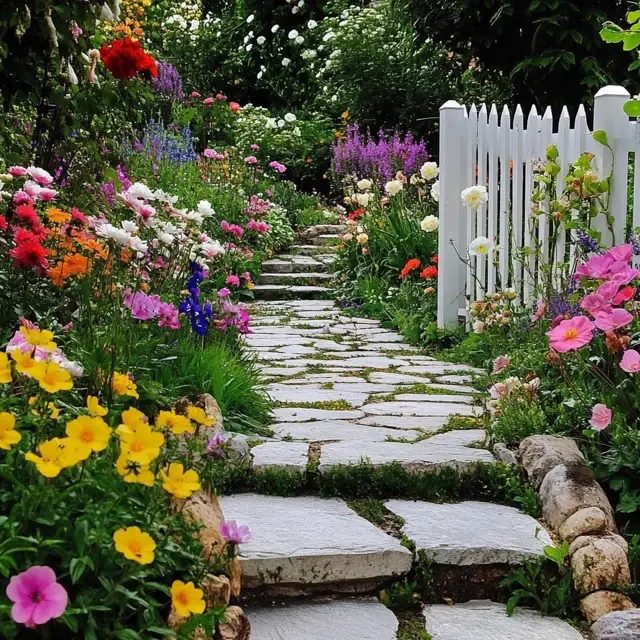
Incorporating Decorative Elements
Decorative elements can enhance the beauty and functionality of your flower garden, adding personality and charm to the space.
Adding Garden Art and Sculptures
Garden art and sculptures can serve as focal points or accents in your flower garden, adding visual interest and a touch of whimsy. Choose pieces that complement the style and theme of your garden, whether it’s a classic statue, a modern metal sculpture, or a rustic piece of driftwood. Place garden art in strategic locations, such as near a seating area, along a pathway, or nestled among the flowers, to create a harmonious and balanced design.
Using Pathways and Edging
Pathways and edging are both functional and decorative elements in a flower garden. Pathways provide access to different parts of your garden and guide visitors through the space. Choose materials like gravel, brick, or stepping stones that complement the style of your garden. Edging helps define flower beds and keeps grass and weeds from encroaching on your plants. Use natural materials like stone or wood, or opt for more formal options like metal or brick edging, to create clean lines and a polished look.
Incorporating Water Features
Water features, such as fountains, ponds, or birdbaths, can add a soothing and tranquil element to your flower garden. The sound of running water creates a peaceful atmosphere, while the reflective surface of a pond adds depth and visual interest. Water features also attract wildlife, such as birds and butterflies, to your garden. When incorporating a water feature, consider its scale and placement to ensure it fits seamlessly into your garden design. Whether you choose a small birdbath or a large pond, a water feature can become a focal point and enhance the overall beauty of your garden.
Lighting Your Flower Garden
Garden lighting extends the enjoyment of your flower garden into the evening hours and adds a magical quality to the space. Use a combination of path lights, spotlights, and string lights to illuminate pathways, highlight key features, and create a warm and inviting ambiance. Solar-powered lights are an eco-friendly option that requires no wiring and can be easily installed throughout your garden. Consider using soft, warm lighting to enhance the natural beauty of your flowers and create a relaxing atmosphere for evening strolls or outdoor gatherings.
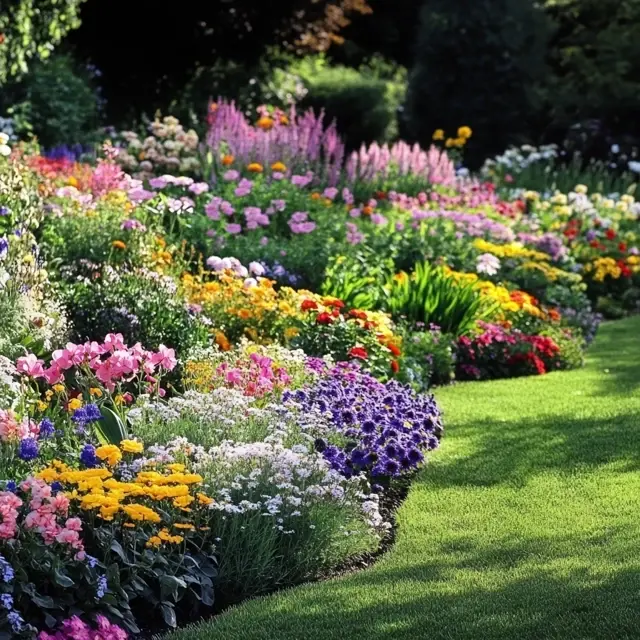
Seasonal Flower Garden Care
Caring for your flower garden is a year-round activity that changes with the seasons. Each season brings its own set of tasks and challenges, and staying on top of garden care ensures that your flowers remain healthy and vibrant.
Spring Planting and Preparation
Spring is the time to prepare your garden for the growing season. Start by clearing away any debris from the winter, such as fallen leaves or dead plant material. Test your soil and add any necessary amendments to improve fertility and drainage. Spring is also the time to plant new flowers, whether you’re starting from seeds or transplants. Be sure to follow planting guidelines for your specific flowers, and water regularly to help them establish strong roots. Consider adding a layer of mulch to retain moisture and suppress weeds as the weather warms up.
Summer Maintenance and Care
Summer is the peak season for most flower gardens, with many plants in full bloom. Regular watering is essential during the hot summer months, so be sure to water deeply and consistently. Deadhead spent flowers to encourage continuous blooming, and keep an eye out for pests and diseases that can damage your plants. Fertilize your garden as needed to support healthy growth, and prune any overgrown or leggy plants to maintain their shape and vigor. Consider adding shade cloth or temporary structures to protect delicate plants from intense sun or heat.
Fall Cleanup and Preparation for Winter
As the growing season comes to an end, fall is the time to prepare your garden for the winter months. Start by cleaning up any dead or decaying plant material to prevent the spread of disease. Cut back perennials that have finished blooming, and divide any overcrowded plants to encourage healthy growth next season. Add a layer of mulch to protect the soil and plant roots from freezing temperatures. Fall is also a good time to plant bulbs for spring flowers, such as tulips and daffodils, ensuring a burst of color when the weather warms up again.
Winter Care and Planning for Next Season
While your flower garden may be dormant in the winter, there are still tasks to be done. Protect any tender plants by covering them with frost cloth or burlap, and keep an eye on mulch levels to ensure adequate insulation. Winter is also a good time to plan for the next growing season. Take note of what worked well in your garden and what didn’t, and start making plans for new plantings or design changes. Consider ordering seeds or plants early to ensure you have everything you need when spring arrives. By staying active in the winter, you’ll be ready to hit the ground running when the growing season begins again.
FAQs
1. What are the best flowers for a beginner’s garden? For beginners, it’s best to choose flowers that are easy to grow and maintain. Some great options include marigolds, zinnias, sunflowers, and geraniums. These flowers are hardy, resistant to pests, and can thrive in a variety of conditions. They also offer vibrant colors and long bloom times, making them perfect for adding instant beauty to your garden.
2. How do I choose the right location for my flower garden? The right location for your flower garden depends on the sunlight and soil conditions. Most flowers need at least 6 to 8 hours of direct sunlight per day, so choose a spot that receives ample sunlight. If your soil is heavy clay or sandy, consider using raised beds or amending the soil with compost to improve its fertility and drainage. Additionally, make sure the location has good drainage to prevent waterlogging and root rot.
3. What is the difference between annuals and perennials? Annuals are plants that complete their life cycle in one growing season, meaning they need to be replanted each year. Perennials, on the other hand, come back year after year, providing long-lasting color and structure to your garden. While annuals often offer more vibrant colors and longer bloom times, perennials require less maintenance and provide continuous interest throughout the seasons. A mix of both can create a dynamic and diverse flower garden.
4. How can I create a focal point in my flower garden? A focal point is a key element that draws the eye and creates a sense of balance in your garden. You can create a focal point with a large plant, a sculpture, a water feature, or even a brightly colored flower bed. Position your focal point in a prominent location, such as at the end of a pathway or in the center of a flower bed, to create a strong visual impact and anchor your garden design.
5. How do I maintain my flower garden throughout the year? Maintaining a flower garden involves regular care and attention. In the spring, prepare your garden by cleaning up debris and planting new flowers. During the summer, focus on watering, deadheading, and fertilizing to keep your garden healthy and blooming. In the fall, clean up and prepare your garden for winter by adding mulch and planting bulbs. In the winter, protect tender plants and plan for the next growing season. Regular maintenance will ensure your garden remains vibrant and beautiful throughout the year.
6. What are some ways to incorporate decorative elements into my garden? Decorative elements can enhance the beauty and personality of your garden. Consider adding garden art and sculptures, such as statues, birdbaths, or metal art, to create focal points or accents. Pathways and edging can define garden beds and guide visitors through your garden. Water features, such as fountains or ponds, add a soothing element, while garden lighting extends the enjoyment of your garden into the evening hours.
7. How can I attract pollinators to my flower garden? To attract pollinators like bees, butterflies, and hummingbirds, plant a variety of flowers that provide nectar and pollen throughout the growing season. Choose flowers in a range of colors, shapes, and sizes to appeal to different pollinators. Native plants are especially important for supporting local pollinators, as they are adapted to the needs of local wildlife. Consider planting flowers like lavender, coneflowers, and milkweed to create a pollinator-friendly garden.
8. What are some common mistakes to avoid in flower garden design? Some common mistakes in flower garden design include overcrowding plants, choosing the wrong plants for your climate or soil type, and failing to plan for year-round interest. Avoid overcrowding by giving plants enough space to grow to their mature size. Choose plants that are well-suited to your local conditions, and plan your garden with a mix of plants that provide color and interest throughout the year. Additionally, avoid planting too many strong-scented flowers in one area, as this can become overwhelming.
9. How do I choose flowers based on color and bloom time? When choosing flowers for your garden, consider how different colors will work together to create a cohesive and visually pleasing palette. Complementary colors create a vibrant and energetic look, while monochromatic schemes offer a more calming and sophisticated feel. Also, consider the bloom time of your flowers to ensure continuous color throughout the growing season. By selecting flowers that bloom at different times, you can create a garden that is always in bloom.
10. What are the benefits of using mulch in my flower garden? Mulch offers several benefits for your flower garden. It helps retain moisture in the soil, reducing the need for frequent watering. Mulch also suppresses weeds, regulates soil temperature, and adds organic matter to the soil as it breaks down. Organic mulch, such as wood chips, straw, or compost, is a great choice for flower gardens, as it improves soil structure and fertility over time. Apply a layer of mulch around your plants, being careful not to cover the stems, to create a healthier and more vibrant garden.
